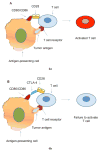Molecular targeted approaches for treatment of pancreatic cancer
- PMID: 21777178
- PMCID: PMC3422746
- DOI: 10.2174/138161211796957427
Molecular targeted approaches for treatment of pancreatic cancer
Abstract
Human pancreatic cancer remains a highly malignant disease with almost similar incidence and mortality despite extensive research. Many targeted therapies are under development. However, clinical investigation showed that single targeted therapies and most combined therapies were not able to improve the prognosis of this disease, even though some of these therapies had excellent anti-tumor effects in pre-clinical models. Cross-talk between cell proliferation signaling pathways may be an important phenomenon in pancreatic cancer, which may result in cancer cell survival even though some pathways are blocked by targeted therapy. Pancreatic cancer may possess different characteristics and targets in different stages of pathogenesis, maintenance and metastasis. Sensitivity to therapy may also vary for cancer cells at different stages. The unique pancreatic cancer structure with abundant stroma creates a tumor microenvironment with hypoxia and low blood perfusion rate, which prevents drug delivery to cancer cells. In this review, the most commonly investigated targeted therapies in pancreatic cancer treatment are discussed. However, how to combine these targeted therapies and/or combine them with chemotherapy to improve the survival rate of pancreatic cancer is still a challenge. Genomic and proteomic studies using pancreatic cancer samples obtained from either biopsy or surgery are recommended to individualize tumor characters and to perform drug sensitivity study in order to design a tailored therapy with minimal side effects. These studies may help to further investigate tumor pathogenesis, maintenance and metastasis to create cellular expression profiles at different stages. Integration of the information obtained needs to be performed from multiple levels and dimensions in order to develop a successful targeted therapy.
Conflict of interest statement
Dr. Buchsbaum has intellectual property interests related to the TRA-8 anti-DR5 antibody.
Figures




Similar articles
-
Pancreatic cancer: optimizing treatment options, new, and emerging targeted therapies.Drug Des Devel Ther. 2015 Jul 7;9:3529-45. doi: 10.2147/DDDT.S60328. eCollection 2015. Drug Des Devel Ther. 2015. PMID: 26185420 Free PMC article. Review.
-
Pancreatic cancer subtypes: a roadmap for precision medicine.Ann Med. 2018 Jun;50(4):277-287. doi: 10.1080/07853890.2018.1453168. Epub 2018 Mar 22. Ann Med. 2018. PMID: 29537309 Free PMC article. Review.
-
Signal Transducer and Activator of Transcription 3, Mediated Remodeling of the Tumor Microenvironment Results in Enhanced Tumor Drug Delivery in a Mouse Model of Pancreatic Cancer.Gastroenterology. 2015 Dec;149(7):1932-1943.e9. doi: 10.1053/j.gastro.2015.07.058. Epub 2015 Aug 7. Gastroenterology. 2015. PMID: 26255562 Free PMC article.
-
Perspectives in the treatment of pancreatic adenocarcinoma.World J Gastroenterol. 2015 Aug 21;21(31):9297-316. doi: 10.3748/wjg.v21.i31.9297. World J Gastroenterol. 2015. PMID: 26309356 Free PMC article. Review.
-
Therapeutic trends in pancreatic ductal adenocarcinoma (PDAC).Expert Opin Investig Drugs. 2019 Feb;28(2):161-177. doi: 10.1080/13543784.2019.1557145. Epub 2018 Dec 16. Expert Opin Investig Drugs. 2019. PMID: 30539678 Review.
Cited by
-
Anti-pancreatic cancer deliverables from sea: first-hand evidence on the efficacy, molecular targets and mode of action for multifarious polyphenols from five different brown-algae.PLoS One. 2013 Apr 16;8(4):e61977. doi: 10.1371/journal.pone.0061977. Print 2013. PLoS One. 2013. PMID: 23613993 Free PMC article.
-
Pancreatic Fibroblasts Stimulate the Motility of Pancreatic Cancer Cells through IGF1/IGF1R Signaling under Hypoxia.PLoS One. 2016 Aug 3;11(8):e0159912. doi: 10.1371/journal.pone.0159912. eCollection 2016. PLoS One. 2016. PMID: 27487118 Free PMC article.
-
Lead identification using 3D models of pancreatic cancer.SLAS Discov. 2022 Apr;27(3):159-166. doi: 10.1016/j.slasd.2022.03.002. Epub 2022 Mar 17. SLAS Discov. 2022. PMID: 35306207 Free PMC article.
-
Disruption of the sorcin‒PAX5 protein‒protein interaction induces ferroptosis by promoting the FBXL12-mediated ubiquitination of ALDH1A1 in pancreatic cancer.J Hematol Oncol. 2025 Mar 7;18(1):27. doi: 10.1186/s13045-025-01680-8. J Hematol Oncol. 2025. PMID: 40055736 Free PMC article.
-
CXCR2 macromolecular complex in pancreatic cancer: a potential therapeutic target in tumor growth.Transl Oncol. 2013 Apr;6(2):216-25. doi: 10.1593/tlo.13133. Epub 2013 Apr 1. Transl Oncol. 2013. PMID: 23544174 Free PMC article.
References
-
- Ellison LF, Wilkins K. An update on cancer survival. Health Rep. 2010;21:55–60. - PubMed
-
- Alexakis N, Halloran C, Raraty M, et al. Current standards of surgery for pancreatic cancer. Br J Surg. 2004;91:1410–27. - PubMed
-
- Kim R. FOLFIRINOX: a new standard treatment for advanced pancreatic cancer? Lancet Oncol. 2011;12:8–9. - PubMed
-
- Joseph I, Tressler R, Bassett E, et al. The telomerase inhibitor imetelstat depletes cancer stem cells in breast and pancreatic cancer cell lines. Cancer Res. 2010;70:9494–504. - PubMed
-
- Kelleher FC. Hedgehog signalling and therapeutics in pancreatic cancer. Carcinogenesis. 2011;32:445–51. - PubMed
Publication types
MeSH terms
Grants and funding
LinkOut - more resources
Full Text Sources
Other Literature Sources
Medical

